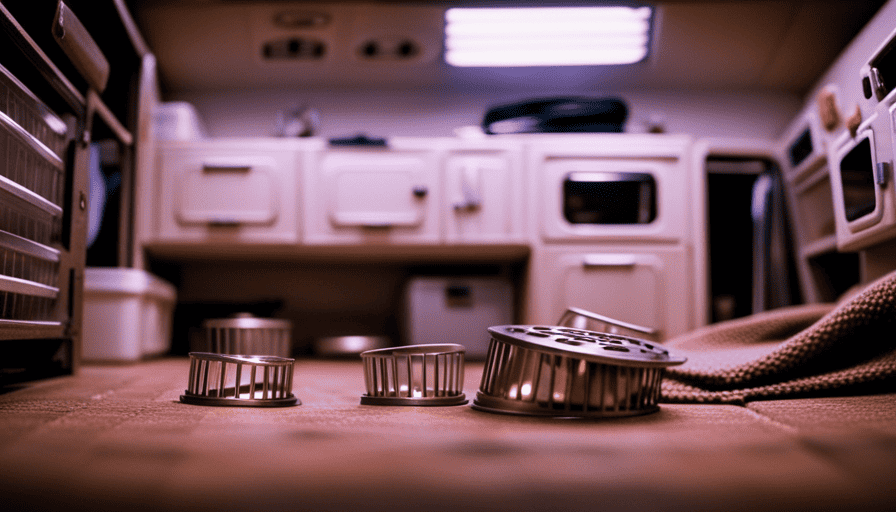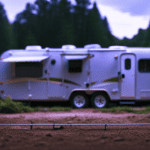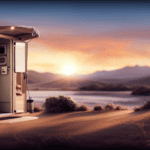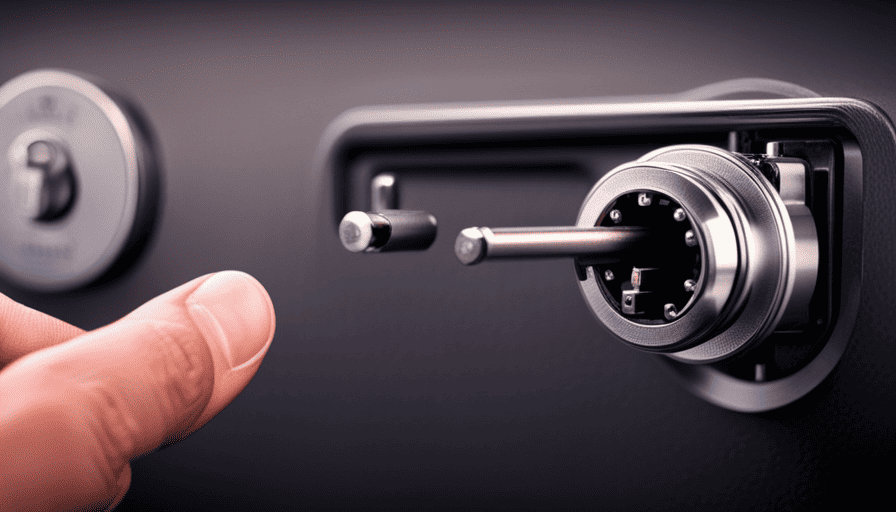So, you’re embarking on an incredible adventure in your reliable camper van. The open roads, the feeling of freedom, and the…rodents? Yes, those pesky little creatures have a knack for finding their way into the tiniest crevices. But fear not, fellow traveler, because I am here to share the tips for getting rid of those unwelcome guests from your beloved mobile home.
In this article, I will guide you through a step-by-step process to rid your camper of those furry invaders. From identifying the signs of a mice infestation to sealing entry points and removing potential food sources, we’ll cover it all. We’ll even explore the use of mouse traps, ultrasonic devices, and professional pest control services.
So, grab your tool kit and let’s get to work. Together, we’ll restore your camper to its pristine, mouse-free state, ensuring that your adventures on the open road are as enjoyable and critter-free as possible.
Let’s dive in and reclaim your camper from those mischievous little rodents once and for all!
Key Takeaways
- Sealing entry points is essential to prevent mice from entering your camper
- Keeping your camper clean and tidy is important to deter mice
- Using traps and baits can help catch and eliminate mice
- Considering natural repellents or professional pest control services if needed
Identify the Signs of a Mice Infestation
You need to be aware of the signs of a mice infestation in your camper, so you can take action immediately. Identifying the early signs is crucial to preventing a full-blown infestation.
The first sign to look out for is droppings. Mice leave small, dark droppings that resemble grains of rice. If you spot these droppings in your camper, it’s a clear indication that mice are present.
Another sign is gnaw marks. Mice have a constant need to chew on things to keep their teeth sharp, so they will leave behind chewed wires, plastic, or even wood.
Additionally, you may notice a strong, musty odor in your camper. Mice urine has a distinct smell that can be quite pungent.
Lastly, keep an eye out for nests made of shredded materials like paper or fabric. These nests are often found in hidden corners or inside cabinets.
It’s important to identify these early signs to avoid potential health risks associated with mice, such as the spread of diseases and allergies.
To prevent mice from entering your camper, the next step is to seal all entry points and create a mouse-proof environment.
Seal Entry Points to Prevent Mice from Entering
To effectively prevent mice from entering your camper, it’s essential to seal all entry points, such as gaps around pipes or vents, thereby ensuring a mouse-free environment. By employing various sealing methods and mouse-proofing techniques, you can safeguard your camper from these unwanted visitors.
One effective way to seal entry points is by using steel wool. Mice are unable to chew through this material, making it an ideal option. Simply stuff steel wool into any openings or gaps where mice could potentially squeeze through. Another effective method is to use caulk or expanding foam to seal larger gaps. Be thorough in your application, ensuring that every crevice is filled.
Additionally, it’s important to inspect your camper regularly for any new entry points that may have emerged. Mice are resourceful creatures and can find ways to enter through even the smallest openings. By staying vigilant, you can identify and seal any new gaps promptly.
By taking these steps to seal entry points in your camper, you can significantly reduce the likelihood of a mice infestation. However, it’s important to remember that prevention is just one aspect of keeping your camper pest-free. To maintain a mouse-free environment, it’s crucial to also keep your camper clean and tidy. [Transition sentence to next section: Now that you’ve sealed off potential entry points, let’s explore how to keep your camper clean and tidy to further deter mice.]
Keep Your Camper Clean and Tidy
Maintaining a clean and organized living space inside your camper is essential in deterring unwanted furry guests. Regularly cleaning and tidying up will help prevent mice from being attracted to your camper.
Here are some cleaning tips and organizing strategies to keep your camper mouse-free.
First, make sure to sweep and vacuum regularly to remove any food crumbs or debris that might attract mice. Pay extra attention to the kitchen area and dining space, as these are common areas where food is consumed. Wipe down countertops and tables with a disinfectant to eliminate any lingering smells that might attract mice.
Next, declutter your camper and remove any unnecessary items that could serve as potential nesting spots for mice. Store food in airtight containers to prevent mice from accessing it. Avoid leaving dirty dishes in the sink overnight, as this can provide a feast for mice.
Additionally, consider using natural deterrents such as peppermint oil or mothballs to repel mice. These strong scents can help keep mice away from your camper.
By following these cleaning tips and organizing strategies, you can create an environment that is less appealing to mice.
In the next section, we will discuss how to remove potential food sources to further discourage these unwanted guests.
Remove Potential Food Sources
Start by eliminating any food sources that might attract unwanted furry guests in your camper. Mice are clever little creatures that can sniff out even the tiniest crumb, so it’s important to keep your camper clean and tidy.
One way to do this is by investing in outdoor storage solutions. Store all food items in airtight containers and keep them in secure compartments outside of your camper. This will not only prevent mice from getting to your food but also deter other pests like raccoons and squirrels.
Proper waste disposal is another crucial step in removing potential food sources for mice. Make sure to dispose of your garbage regularly and securely. Avoid leaving any food scraps or crumbs around your camper, especially in areas like the kitchen or dining area.
By following these simple steps, you can significantly reduce the chances of mice infesting your camper. Now, let’s move on to the next section and learn how to use mouse traps and baits effectively.
Use Mouse Traps and Baits
When it comes to dealing with unwanted furry guests in your camper, one effective solution is using mouse traps and baits. These methods can help you catch and eliminate mice from your camper, preventing any further damage or health risks they may pose.
Here are three mouse trapping and baiting methods you can try:
-
Snap Traps: These are the most common and traditional type of mouse traps. They consist of a spring-loaded mechanism that snaps shut when the mouse triggers it. Place these traps in areas where you’ve noticed mouse activity, such as near food storage or nesting sites.
-
Glue Traps: Glue traps are another option to consider. They have a sticky surface that captures mice when they walk over it. Place these traps in areas where mice are likely to travel, such as along walls or near entry points.
-
Bait Stations: Bait stations are enclosed boxes that contain mouse bait, such as poison or food. Mice enter the station to access the bait but are unable to escape. This method is effective for larger infestations or when other trapping methods have failed.
While mouse traps and baits are effective, it’s important to consider natural repellents as an alternative pest control method. These options can help prevent mice from entering your camper in the first place, reducing the need for trapping and baiting.
Consider Natural Repellents
To enhance your pest control efforts, you might want to explore the effectiveness of natural repellents in keeping those unwanted furry invaders out of your camper.
One option is to use essential oils, as mice are repelled by certain scents. Peppermint oil is particularly effective in deterring mice, as they find its strong smell overwhelming and will typically stay away from areas where it is present. Simply soak cotton balls with a few drops of peppermint oil and place them strategically around your camper, focusing on entry points and areas where you’ve noticed mouse activity.
Another option is to try electronic repellents. These devices emit high-frequency sound waves that are inaudible to humans but highly unpleasant for mice. They work by creating an environment that mice find uncomfortable and will want to avoid. You can find a variety of electronic repellents on the market, ranging from plug-in devices to battery-operated ones. Consider placing them near areas where mice are most likely to enter your camper, such as doors and windows.
Using natural repellents and electronic devices can be effective in keeping mice away from your camper. However, if you’re dealing with a severe infestation or want to take additional measures, you may want to consider using ultrasonic devices to deter mice. These devices emit ultrasonic sound waves that are highly irritating to mice, causing them to flee from the area. With the combination of these methods, you’ll have a better chance of keeping your camper mouse-free.
Use Ultrasonic Devices to Deter Mice
Consider using ultrasonic devices in your camper to give mice a taste of their own medicine and send them running for the hills. Here’s why ultrasonic devices can be an effective solution for mouse deterrence:
-
Easy to use: Ultrasonic devices are simple to install and operate. Just plug them in and let them do their job.
-
Chemical-free: Unlike traditional pest control methods, ultrasonic devices don’t require the use of harmful chemicals. This makes them safe for both humans and pets.
-
Coverage range: Many ultrasonic devices have a wide coverage range, making them suitable for large campers or RVs.
However, it’s important to note that the effectiveness of ultrasonic devices can vary depending on the camping environment. These devices may work well in enclosed spaces, such as campers with limited entry points. However, in open or outdoor camping areas, their effectiveness may be reduced.
Ultrasonic devices can be a practical and chemical-free option for deterring mice in your camper. While they may not be 100% effective in all camping environments, they can still provide a significant level of protection. If you’re still experiencing mouse issues despite using ultrasonic devices, it may be time to consult professional pest control services. They can provide you with expert advice and tailored solutions to effectively address your mouse problem.
Consult Professional Pest Control Services
If you’re ready to tackle your mouse problem head-on, it’s time to reach out to professional pest control services for expert assistance. Hiring professionals to handle your mice infestation can bring several benefits.
Firstly, they have the knowledge and experience to effectively eliminate mice from your camper. They can identify the entry points and nesting areas, ensuring a thorough removal process.
Additionally, professional pest control services offer cost-effective solutions. While DIY methods might seem cheaper initially, they may not provide a long-term solution. Pest control experts can address the root cause of the infestation, preventing future occurrences and saving you money in the long run.
When it comes to dealing with mice in your camper, consulting professional pest control services is the way to go. They have the expertise to handle the situation efficiently and provide a permanent solution.
However, it’s not enough to rely solely on professional help. To maintain a mouse-free camper, it’s essential to regularly inspect and maintain it. This includes sealing any gaps or cracks where mice can enter, keeping food properly stored, and cleaning up any potential attractants.
By combining the expertise of professional pest control services with regular camper maintenance, you can effectively keep mice out and enjoy a rodent-free camping experience.
Regularly Inspect and Maintain Your Camper
Don’t bother inspecting and maintaining your camper regularly; the mice will surely appreciate the cozy and welcoming environment you’ve created for them. To keep these unwanted guests away, it’s essential to inspect and maintain your camper on a regular basis. Here are some key steps to ensure your camper remains mouse-free:
-
Check for any openings or cracks in the exterior of your camper where mice can enter. Seal these gaps using caulk or steel wool.
-
Inspect the interior of your camper thoroughly, paying close attention to hidden corners, cabinets, and storage compartments. Mice can squeeze through tiny openings, so be meticulous in your search.
-
Clean up any food crumbs or spills promptly. Mice are attracted to food sources, so keeping your camper clean and free of enticing odors is crucial.
-
Remove any potential nesting materials such as paper, fabric, or cardboard. Mice love to build nests in cozy spots.
-
Set up mouse traps strategically around your camper to catch any mice that may have already found their way in.
By regularly inspecting and maintaining your camper, you can identify and address any potential entry points or signs of mouse activity. This proactive approach will help prevent future infestations.
Take Preventive Measures to Avoid Future Infestations
To keep your camper free from unwanted visitors, take proactive measures to prevent future infestations. One of the common mistakes when trying to get rid of mice in a camper is not addressing the underlying causes of the infestation. Simply removing the mice without addressing the conditions that attracted them will only lead to more problems down the line.
Therefore, it’s important to identify and seal any potential entry points for mice, such as gaps or holes in the camper’s exterior. Additionally, make sure to regularly inspect and repair any damaged screens or vents that could serve as entry points.
Another important preventive measure is to store food effectively to prevent mice infestations in a camper. Mice are attracted to food sources, so it’s crucial to store all food in airtight containers that mice can’t access. This includes not leaving any food out overnight and properly disposing of any food waste.
Keep your camper clean and free of crumbs or food debris, as even the smallest trace of food can attract mice.
By taking these preventive measures, you can significantly reduce the chances of future mice infestations in your camper. Stay vigilant and regularly inspect your camper to ensure it remains pest-free.
Frequently Asked Questions
Are mice infestations common in campers?
Mice infestations are relatively common in campers. These small creatures can easily find their way into your camper, attracted by the availability of food and shelter. However, there are prevention measures you can take to minimize the risk.
Keep your camper clean and remove any potential food sources. Seal any openings or cracks where mice can enter. Additionally, using the best traps, such as snap traps or live traps, can help you effectively eliminate mice from your camper.
Can mice cause damage to my camper?
Mice can indeed cause damage to your camper. They can chew through wires, insulation, and even upholstery, leading to costly repairs. To prevent infestations, it’s important to seal any openings or cracks in your camper, as mice can squeeze through tiny spaces.
Additionally, keep your camper clean and free of food crumbs, as this will deter them from entering. Regularly inspect your camper for any signs of mice and promptly address any issues to prevent further damage.
How long does it take to get rid of mice in a camper?
Getting rid of mice in a camper can take some time and effort, but it’s definitely doable. The duration of the process depends on several factors such as the severity of the infestation and the methods used. It usually takes a few weeks to completely eliminate mice from a camper.
To prevent infestations in the future, it’s important to seal any entry points, store food properly, and keep the camper clean and clutter-free.
Are there any health risks associated with mice in campers?
Are there any health risks associated with mice in campers?
While mice in campers can be a nuisance, they also pose potential health risks. These rodents can contaminate food and surfaces with their urine, droppings, and saliva, which can transmit diseases such as hantavirus and salmonellosis.
To prevent these health risks, it’s essential to keep your camper clean, seal any potential entry points, store food properly, and consider using mouse traps or repellents.
What are some signs that mice have returned after previously being removed from a camper?
Some signs of recurring mice infestation in a camper include finding droppings, chewed wires or fabrics, and hearing scratching or squeaking noises.
To prevent mice from returning, make sure to seal any cracks or openings in the camper, store food in airtight containers, and keep the camper clean and free of clutter.
Additionally, placing mouse traps or using natural deterrents like peppermint oil can help keep mice away.
Conclusion
In conclusion, getting rid of mice in your camper can be a challenging task, but with the right approach, it’s definitely achievable. Here are the steps you can take:
- Identify the signs of a mice infestation.
- Seal entry points.
- Keep your camper clean.
- Remove potential food sources.
- Use traps and baits.
- Utilize ultrasonic devices.
- Consult professional pest control services.
- Regularly inspect and maintain your camper.
- Take preventive measures.
Remember, an ounce of prevention is worth a pound of cure. So don’t wait, take action today to make your camper mouse-free and enjoy your travels without any unwanted visitors.



















